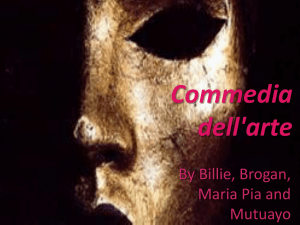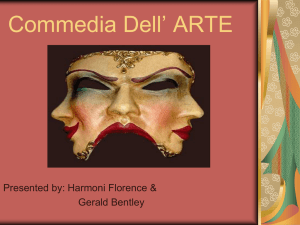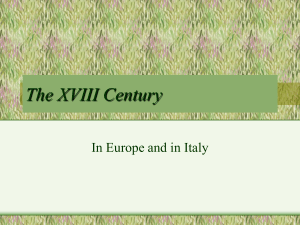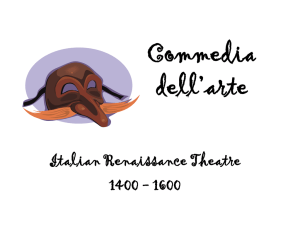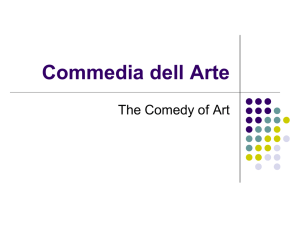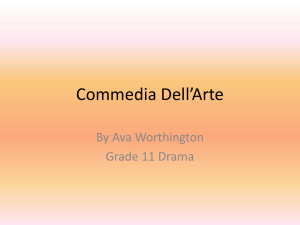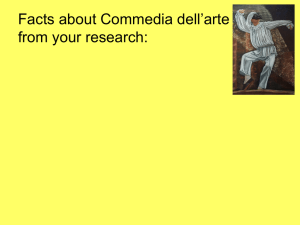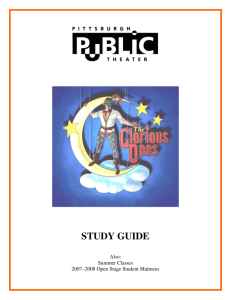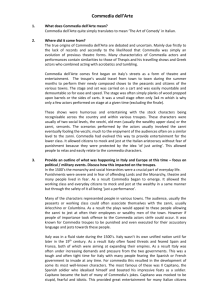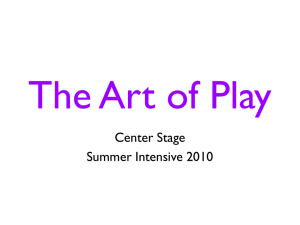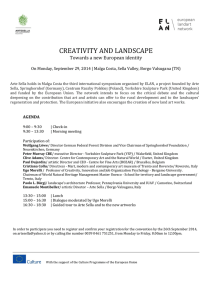Commedia dell`Arte
advertisement
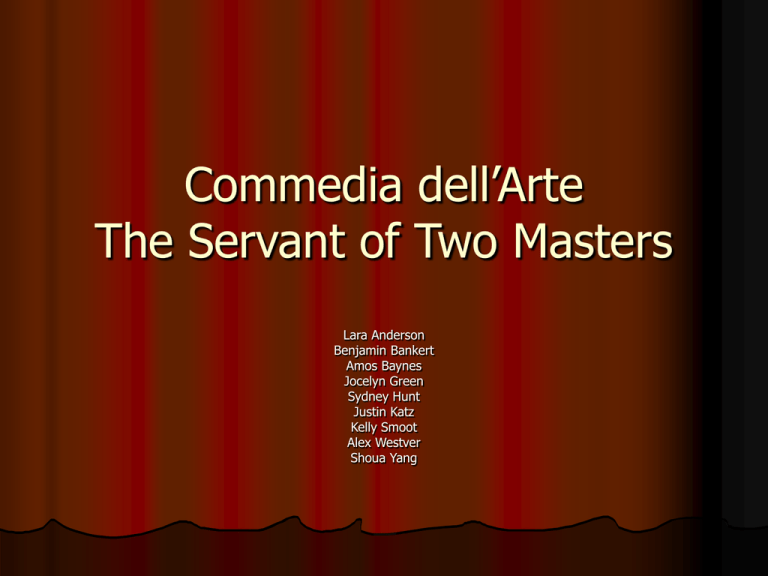
Commedia dell’Arte The Servant of Two Masters Lara Anderson Benjamin Bankert Amos Baynes Jocelyn Green Sydney Hunt Justin Katz Kelly Smoot Alex Westver Shoua Yang Italian Renaissance 14th-15th Centuries beginning in Northern Italy Reawakened interest in Greek and Roman thought, literature, and art Early 16th Century – classic plays were written in Italian The plays became the standard at festivals which were organized and produced by the community to celebrate weddings, royal birth, and visits of emissaries from other states. The influence of religion was fading and a new age of humanism and self-interest arose. Commedia dell’Arte Commedia dell’Arte combined professional and public theater First historically recorded in the 1560s Most popular between 1575 and 1650, but continued into the late 18th Century Venice was the center of Commedia dell’Arte Origin? Mimes and other entertainers in Roman times Improvisations based on the Roman comedies of Plautus and Terence By 1600s, Commedia dell’Arte troupes were performing in France, Spain, and other European countries. Essentials of Commedia dell’Arte The actor = heart Performances were flexible and adaptable. Script provided a scenario (summarizing the situations, complications, and outcomes) and the actors provided the dialogue and actions. Audience and category The audience’s reactions influenced each performance. Categories of Commedia dell’Arte Tragedy Melodrama Musical Comedy – most popular! Performing Commedia dell’Arte Actors within a troupe played the same roles and improvised the “script” for each performance. Improvisation was a distinctive feature of Commedia dell’Arte. Actors often reused pieces of comedic business (lazzi). Ex. Sack lazzi, fight lazzi, and lazzi of fear Actors Best known feature of Commedia dell’Arte Males and females performed Troupes traveled frequently and contained an average of 10 to 12 members, while working under a sharing plan. Stock Characters Three Categories The Lovers (2 sets) – most realistic The Masters (3) – reoccur most often The Servants (zanni)most varied, mostly male Arlecchino =(Harlequin) the most popular Pantalone Fixed Costume Red vest, breeches, and stockings Ankle-length black coat Brown mask with a large hooked nose Scraggly gray beard Dr. Lombardi Fixed Costume Academic Cap Popular gown of the time period Half-Mask Costumes Half Masks for most characters Latest fashions for lovers (no masks) Fixed costumes for some characters Popular Men’s Fashion Bob-wigs Frock Coats Elaborate cuffs, fronts, and cravats!!! Silks, Gold and Silver Thread, Lace The Latest in Men’s Fashion Bob-wigs Frock Coats Elaborate cuffs, fronts and cravats!!! Silks, Gold and Silver Thread, Lace Popular Women’s Fashion Small caps and tight curls in hair Large circular hoop skirts Gowns heavily embellished like men’s clothing!!! Popular Fashions for Lovers (but no masks) History of Italian Theater Italian festivals drew on classical sources [Such as Vitruvius (Roman architect of the 1st century B.C.)] Vitruvius described how a theater is laid out and the settings for tragedy, comedy, and pastoral. History Continued Italians created the theater structure and scenic practices that would dominate the European theater into the 20th Century. No permanent theater spaces; Used temporary performances spaces in large halls. Pictorial Stage 1500s – Italian Renaissance moved away from the formal and architectural stage to the representational and pictorial stage. With perspective, each place was represented in 3 dimensions, as seen from a fixed eye point (much like looking at a painting). 1600s - Pictorial presentation would become the standard for stage scenery throughout Europe. Perspective Drawing Eventually accepted everywhere, 3 scenic elements: side wings, backdrops, and overhead borders. The floor was raked upward toward the back (upstage, downstage) and a proscenium arch was used to frame the stage. Shifted scenery during interludes (Intermizzi) during performances. Led to the birth of Italian Opera (1590s) Opera popular because it combined drama, music, dance, spectacle, and special effects. Italian Theaters & Opera Houses Oldest surviving proscenium theater – Teatro Farnese, Parma, Italy built in 1618 5 levels of spectators 3 Divisions – separate different social classes Box: upper-class Pit (today’s orchestra) Gallery: lower/working-class Music and Lighting Stringed Instruments Guitar, Violin, Mandolin (most popular) Candles and oil-lamps Footlights and sidelights were developed in 1628 by Joseph Furstenbach Nicoli Sabbatini developed a system of dimming lights in 1638 18th Century Music Halls The music in Italy advanced to a great extent during this century. It is the time in which the great opera houses in Naples, the San Carlo Theater and in Milano, La Scala were built. These light-hearted musical plays began to be offered as an alternative to weightier opera seria (17th-century Italian opera based on classical mythology). The San Carlo Theater, Naples La Scala, Milano Carlo Osvaldo Goldoni Born in Venice, Italy in 1707 Italy’s most famous comic dramatist Began writing scenarios for commedia companies in Venice around 1734 because he felt the current situations were trite and vulgar Many of his plays are still performed today As Goldoni wrote more plays, they became less improvisational and more scripted Goldoni Timeline Carlo Osvaldo Goldoni (1707) Born in Venice (1723) Studied at Collegio Ghislieri in Pavia (1725) Wrote Libellias poem and forced to leave Pavia, studied at Udine and Modena (1731) father died (1732) to avoid marriage left Venice for Milan then Verona, Married Nicoletta Conio (1738) Produced first real comedy L'uomo di mondo ("The Man of the World") (1757) Engaged in dispute with Carlo Gozzi (1761) Moved to Paris (1771) Le Bourru bienfaisant for Louis XVI and Marie Antoinette (1793) died in France Carlos Controversy Advocated for the abandonment of masks because they handicapped the actors by hiding their facial expressions With the help of Carlo Gozzi (Goldoni’s rival), the art of Commedia dell’Arte diminished, although many scenarios have survived. Goldoni died in 1793 in France Legacy As Goldoni wrote more plays, they became less improvisational and more scripted Advocated for the abandonment of masks because they handicapped the actors by hiding their facial expressions With the help of Carlo Gozzi (Goldoni’s rival), the art of Commedia dell’Arte diminished, although many scenarios have survived. Goldoni died in 1793 in France The Servant of Two Masters Written in 1745 for a Venetian troupe Less exaggerated than typical Commedia dell’Arte plays Middle class characters were treated with respect and women were seen as more sensible than men. Lacks coarse humor and sexual innuendos of previous commedia Plots and Themes Disguise Coincidence Misunderstandings Withholding Information Reversal of Social Roles Self Interest Characters Masters Lovers Pantalone, Venetian Merchant Dr. Lombardi Clarice and Silvio Beatrice (“Federigo”) Rasponi and Florindo Aretusi Servants Truffaldino Smeraldina, maidservant of Clarice Brighella, the innkeeper Truffaldino Most varied costume in productions Red, green, blue diamond-shaped pattern Rakish hat Black half-mask Slapstick – used to enhance violence and comedic performance Scenery Three Acts with 10 scenes Only requires five settings A room in Pantalone’s home The Courtyard of Pantalone’s home The Street in front of Brighella’s inn A room inside the Inn A street Little or no furniture A sign depicting the entrance of Brighella’s Inn Summary of the Play Clarice dei Bisognosi was engaged to marry Federigo Rasponi But Federigo dies (accident with a sword very sad) So Clarice is engaged to Silvio Lombardi (nice guy) (The thought dead) Federigo shows up at Clarice’s house Federigo is actually his sister Beatrice Rasponi (in drag disguise) Then Florindo (Beatrice’s lover) shows up looking for Beatrice Confusion is caused by the servant Truffaldino (the guy in diamond pattern) He is the servant to both Federigo (actually Beatrice) and Florindo Truffaldino fed the masters and lovers misinformation that causes confusion Clarice and Silvio almost break up (Silvio wants to kill Florindo) Truffaldino and Beatrice reveal their true selves The revelation leads to a happy ending for everyone (even Truffaldino is getting married!) Fun and Interesting Facts Goldoni was “finacially challenged” (a.k.a. poor) due to his extravagant spending on luxuries. Goldoni was an notoriously honest man; playing fair even when he knew his comerades were cheating (which also led to his finacial difficulties). Theaters during Goldoni’s time featured oillamps that not only produced a great deal of smoke, but also gave off a foul odor due to the burning of low quality oil. Any questions?
